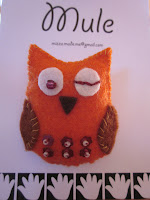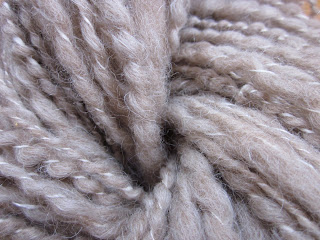Mule is a nano craft business based in Northcote.
I make:
* Hand-knitted scarves and mittlets from hand-spun, hand-dyed merino, silk & alpaca
* Hand-stitched felt brooches & barrettes
* Knitting bags, knitting needle wallets & whatnot purses
 |
| Mittlets | | |
 |
| Felty brooches |
 |
| Felt barrettes |
 |
| Kimi knitting bag & needle wallet |
 |
| Owly knitting bag & needle wallet |
 |
| Babushka knitting bag & needle wallet |
 |
| Penny Malone fabric bags |
 |
| Birdy needle wallet & knitting bag |
 |
| Whatnot zipper purse |
 |
| More felt barrettes |
|
|
|
 |
| Little gift cards |
Why Mule?
It's actually a nickname (thank you Lana!) but it seemed especially apt when I discovered that the 'spinning mule' was invented by a bloke called Samuel Crompton in England in 1779.
Stories from a spin-head
When my cobber Janet from Slow Spun (slowspun.blogspot.com.au) first taught me to spin on her Wendy wheel in July 2011 (it's pictured here with a broken treadle), I thought it would be something I did for a few hours before being overcome with Olympic-level boredom.
She gave me some moorit to practise with, which is easy to fluff up and feed into the 'orifice' (the little holey thing on the spindle). It was hilarious at first. I kept squealing like a girlie dork whenever the fleece whirled through too fast in a giant clump and jammed the spindle, but Janet was incredibly patient with me: showing me how to untwist the overwrought fibres and feed them through again.
The first bobbin of 'yarn' was so lumpy that I couldn't ply it with another bobbin of my own spinning (it would have been too porky for the orifice). Janet came to the rescue and spun some silk for me to use instead. I plied it with the moorit and ta-da! My first skein. To be honest, I thought it looked pretty wonky, but Janet insisted that the chunkiness was magnificent and that I should
knit something with it.
So I knitted a shawl that wouldn't have looked out of place flung over one brawny shoulder of Lud the Conquerer.
One month later...
I tried spinning some fine merino, which was incredibly soft, and then some alpaca, which was very hard to spin (it's 'slippery') but
so smoodgy, especially plied with silk.
 |
| Wonky alpaca & silk |
 |
| Wonky alpaca & silk scarf |
 |
| Navy blue & natural merino |
 |
| Navy & natural merino dyed lucerne green |
Two months later...
Spinning had become much easier and I was pretty much hooked. I began to muck around with dyes (the Landscape ones). It was great not knowing what colour a skein was going to turn out...
Six months later...
It was time to return Janet's wheel and get my own. I contacted spinners and weavers guilds all over the place, trying to find an upright wheel in good condition. I finally found a Wee Peggy for sale in South Australia, and drove there to pick it up from 84-year-old Magda. She'd had it since 1979 (her hubby had assmbled it from an Ashford kit sent over from New Zealand). It was in pretty good nick, but she'd spun the guts out of it! The timber on the flyer had a deep groove, and each of the hooks was almost sliced through from the thousands of kilometres of yarn she'd spun.
 |
| 1979 Wee Peggy (oops, I cut the maiden off) |
I reglued the legs, replaced the hooks, sanded the grooves in the flyer whorl and gave it a good lube and it spun beautifully.
May 2012
Next stop was carding fleece. I checked out a few YouTube clips that featured energetic nannas dancing with spiky-looking brushes. How hard could it be? As it turned out, the carding was the easy bit – selecting the right kind of fleece was a whole other ball game.
I bought some black and white alpaca fleece off ebay, and even though the seller kindly pointed out that it contained 'vegetable matter', I wasn't prepared for the bucket of compost that fell out when I opened the bag! I'm talking the crunchy carapaces of long-dead beetles and sticks that could poke a young kiddy's eye out! It took two days to pick 400g of it clean, and then another day to card it.
Finally, I plied 100g of it with some indigo silk...
But it was still a bit coarse, so I plied it again with a bobbin of black merino – much better. (I composted the rest!)
I had better luck with some white alpaca, though it still took a day to clean the sticks and guff out.
Here's what it looked like after it was carded, plied with merino and dyed 'alfalfa'.
And dyed 'barossa'.










































